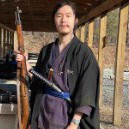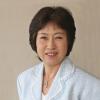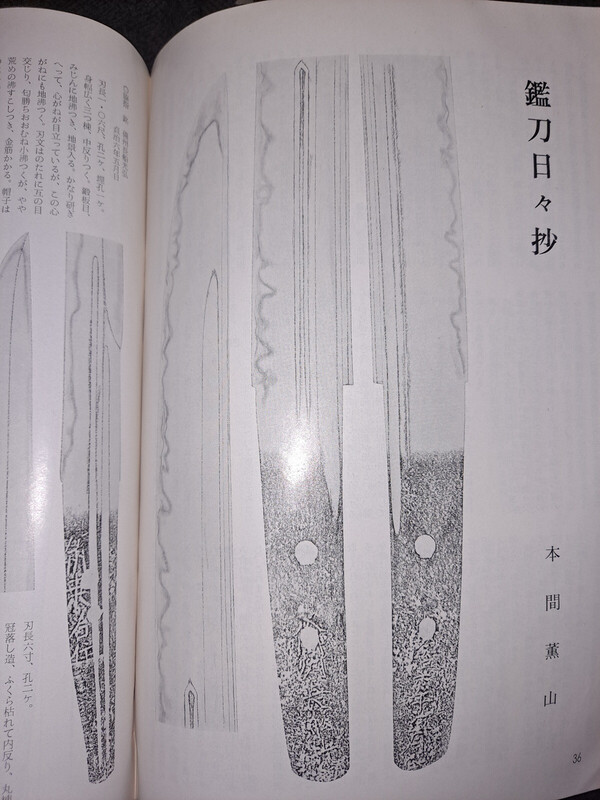-
Posts
1,780 -
Joined
-
Last visited
-
Days Won
28
Jussi Ekholm last won the day on December 11 2023
Jussi Ekholm had the most liked content!
About Jussi Ekholm

- Birthday 12/29/1988
Profile Information
-
Gender
Male
-
Location:
Tampere, Finland
Profile Fields
-
Name
Jussi Ekholm
Jussi Ekholm's Achievements
-

For your daily check list..
Jussi Ekholm replied to BIG's topic in Auctions and Online Sales or Sellers
Nice list of dealers, many of them very high end. I think there was one bit of misinformation in the article. Authentic Japanese sword do NOT need NBTHK authentication to be considered as authentic. -
Like others I would think ubu late Muromachi blade.
-
I believe mumei Bizen Yoshimitsu (賀光) as an attribution would be a mid-Muromachi attribution. I have not tracked work of these Yoshimitsu smiths as the earliest dated works I remember finding have been in Kanshō (1460 - 1466), and more works after that. Of course that would depend on how long you see early Muromachi going for and when you think it is mid-Muromachi as I don't think there are exact dates.
-
To my knowledge there is no public database of papered items, and no private data for members either. Staff most likely has the access to data as they can check the certificates. I agree with much that has been said earlier on this thread and it is complicated matter. It is unfortunate that probably NBTHK wont see international members (or non-members) as huge source to invest in as we are so few in numbers (international members). Still I think if I had any good ideas I should try to send them directly to NBTHK. Unfortunately haven't gotten them yet I never visited the old NBTHK museum so I cannot comment on that. I remember last summer I thought I would use the NBTHK reading room when visiting the museum but I was adviced I would need to call and reserve it in advance. Which I felt might be a bit complicated process with my very limited Japanese. As for comparison I was able to use Tokyo National Museum research facilities without prior reservations and got my hands on some books after filling in proper requests for them by their computer. I think I might try to reach out NBTHK if I could try to use their reading facilities this summer and see how that will go and what references I might be able to request. NBTHK publishes the Jūyō & Tokubetsu Jūyō books for every session and they are a huge resource. I believe when visiting NBTHK reading room you could request for example specific Jūyō book to study. So living in Tokyo area it would be easy to study them, for us international folks it is much harder often needing to buy the book(s) if wanting to study the items.
-
I have voiced my opinions and thoughts about NBTHK shinsa in few threads lately, even though I am a long time member who has never submitted anything to shinsa. I hate to talk swords, fittings etc. and money. Ideally I would leave money completely out and just discuss the items. However over the years NBTHK has achieved monopoly position in appraisal market and I don't think that is a good thing. Of course as I wrote examples at last post on this subject how much revenue NBTHK is creating on the shinsa. I think they have calculated the maximum numbers that they reduce the panic of deadlines while still keep the organization running financially on solid base. I believe they had to set the limits per session as more and more items were being submitted each time. Hopefully NTHK / NTHK-NPO, JASMK etc. organizations would get more recognition by the community and could perhaps try to up their game a bit in the appraisal field. It is not a good thing if pretty much only certificates by 1 organization are held in value. For monetary value the NBTHK appraisal can carry huge difference, for example depending what attribution the mumei sword gets...
-

Opinion about Usa Kunimune.hira zukuri sword
Jussi Ekholm replied to Mormo's topic in Auctions and Online Sales or Sellers
It is quite rare to have so long hira-zukuri katana. NBTHK states in brackets that it is (Uda school - late Muromachi). I am actually not sure what the 2nd paper is, to me it seems to be NTHK paper but it is unlike other NTHK papers I have seen. Is it possibly the very low rank NTHK Shinteisho? I have never seen those in person so I cannot say for sure. The NTHK paper also gives Bunmei (1469 - 1487) as an era. I think it is interesting item but unfortunately condition might have issues. -
Unfortunately there are no English translations that I am aware of. I think the problem in selling these and my other books is that they are highly specialized so the number of interested buyers world wide is extremely small. That is the problem when I keep searching more and more specialized and specific books, selling them will be almost impossible. I asked the postage costs to USA for the TJ set and it seems to be c.75€ so bit expensive. I thought from the beginning that these would be a hard sale but I did think that Sesko Meikan set would sell quite fast.
-
NBTHK publishes the financial report yearly, so it is easy to see where the money comes in. It is featured every year in Tōken Bijutsu magazine. I won't post exact numbers here but I can list few things to give some insight. Reiwa 5 - 2023 report Jūyō shinsa makes little bit more money than full year of NBTHK Sword museum admissions. Yearly Hozon/Tokubetsu Hozon shinsa generate roughly 8x the money yearly NBTHK Sword museum admissions. (This seemed to be very good financial year for museum admissions vs. previous ones) Reiwa 4 - 2022 report Jūyō shinsa makes bit over 4x money vs. full year of NBTHK Sword museum admissions. (I believe this financial year had TJ shinsa too) Yearly Hozon/Tokubetsu Hozon shinsa generate roughly 15x the money yearly NBTHK Sword museum admissions. Reiwa 3 - 2021 report Jūyō shinsa makes c. 2,8x money vs. full year of NBTHK Sword museum admissions. Yearly Hozon/Tokubetsu Hozon shinsa generate roughly 15x the money yearly NBTHK Sword museum admissions. I am not interested in economics or money stuff in general but it is easy to see that shinsa sessions are huge source of revenue for NBTHK. Those interested in financial stuff can pick up the May issues of the magazines as they have the full information with exact numbers. However the money brought in by shinsa sessions actually provide the means to NBTHK to carry out their purpose as listed above. You need enough money to cover the expenses of the organization (which are also listed in the report) in order to keep it running.
-
I am a fairly longtime member of NBTHK and I am supporting the organization as I believe they are doing many good things. However I have never sent anything to shinsa and for the forseeable future I wont at least in few upcoming years. This is bit astray from the original topic but as I feel the discussion is quite interesting. While I do believe the system that Japanese shinsa provide, however I believe for all of the organizations it is business. And while various organizations of course work as well as they can, there are several factors that affect their full capability. Here it should be noted that I have never been even close to a shinsa session and do not really know how they work. For NBTHK time seems to be a limiting factor. As some may know NBTHK has now put a maximum number of 1,600 blades for Hozon / Tokubetsu Hozon tōken shinsa. I do think the submission numbers were higher than that recently so they had to put a limit in order to manage deadlines. I am not priviledged enough to know how they process the swords and evaluate them but when you process 1,600 swords within a limited time, you cannot actually spend huge amount of time per one blade. I remember few years ago I discussed this a bit with Darcy and perhaps we tried to crank some numbers. I am not mathematically that good but I know that big number of items with limited time equals little time per each item. Here are some numbers for recent Jūyō shinsa that are of course previously already passed Tokubetsu Hozon, so items are already verified. Session 69 - Application period 2.10. - 4.10. and 828 blades were sent in. Final judging for swords 1.11. and 56 blades passed. Session 68 - Application period 3.10. - 5.10. and 817 blades were sent in. Final judging for swords 2.11. and 66 blades passed. Session 67 - Application period 4.10. - 6.10. and 852 blades were sent in. Final judging for swords 29.10. and 111 blades passed. I do believe NBTHK probably might have one of the largest reference collections. Plus I believe they do keep a record of all issued certificates but I believe they would classify them by number as that will make it easiest to search specific certificate numbers. As that is the most logical way to keep them. I would also believe that access to NBTHK certificate data is to staff only. However with the reference materials I can focus on the second issue time vs. reference materials. As we all know there are some common references where we usually check the signatures. However in order to make a reference book effective you can only feature X number of items per specific smith. When working with time restraints there is a limit how much research you can do. When you have to go through hundreds of signatures within one month it gets bit limited compared to researching one specific signature for multiple months. I take Bizen Nagamitsu (長光) here as an example. Fujishiro - 8 reference mei Sesko Meikan - 11 reference mei In my personal references I have 207 different (verified by experts) signed items by Nagamitsu The reference books will create a good general base for signatures but there are possibilities not featured in common references. Of course in general you don't have to dig up all the possible reference signatures of the smith but sometimes few in common references might not be enough. And the final thought on my mind that must be considered is expert knowledge. I have never attended NBTHK meeting in Japan but the times in Europe I have been around senior NBTHK-EB members I have been astonished by their kantei skill and knowledge when quickly viewing items. The kantei sessions in both years at Utrecht were really nice to see how much details people pick up in extremely short viewing. I will always remember taking my own tachi to NBTHK Scandinavia meeting where a senior member told me fine details after a minute or so viewing the sword that I did not know about my own sword I had owned for quite a while... I think that my point is to encourage doing research and having fun doing it but at the same time there is a reason why NTHK or NBTHK shinsa team would have certain members, they are experts.
- 98 replies
-
- 10
-

-

-

-
I don't really like the item from Aoi Art, there are some things on it that I am puzzled by a bit. For Nanbokuchō Masahiro you most often will find short & wide wakizashi instead of tantō length blades. I will also recommend budget of 10,000$+ even for the "lower" tier verified mumei items, and these will be also very difficult to find. Signed and dated ones, good luck finding available ones... Here are few references for you. This was 11,500$, very nice item: https://web.archive....0/Soshu_Masahiro.htm I didn't get the price for this but nice item: https://nihontoantiq...ahiro-sword-fss-857/ Personally didn't like this as much, 1,6M yen: https://www.seiyudo.com/ta-010121.htm
-
Hello! Yes I mean that smith. Unfortunately his work seems to be super rare. So far in all my years tracking down old items I think I have only came to see 3 items signed by this smith. Here is attached the only one of those that I have picture other than the signature so some working style can be seen. While being so rare and would be a very uncommon attribution it is probably the only Mitsuhiro (光弘) smith I can think of.
-

Help Translating and Evaluating if Real
Jussi Ekholm replied to Kata24's topic in Translation Assistance
Steve is correct and I believe the NBTHK paper is fake. However I must admit it seems to be a good fake. Here are some things explained that I see as problematic. 1. Like Steve said if there is signature on both sides, then there will be oshigata or picture of both sides of the nakago. 2. NBTHK stopped using oshigata in mid Showa 62 (1987), after that they use pictures. 3. While uncommon as the length is so slighty above X shaku NBTHK actually uses 0 on the paper when it is X shaku but under 1 sun and features X bu. 4. The number of the paper is hidden in the picture, however it seems to have 6 numbers. Hozon papers for blades from 2015 have 7 numbers, 300XXXX and very late in the year they start to be 301XXXX. 5. There actually was no Hozon/Tokubetsu Hozon session for blades in 6th month of 2015. The blade sessions around that time were in May (5th month) and July (7th month) Out of curiosity where did you purchase this sword? -
Could it be an old attribution towards Nanbokuchō Kozori smith Mitsuhiro?


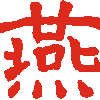


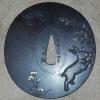

.thumb.jpg.77d8b8ceaccc15be659eed179b42bff3.jpg)
